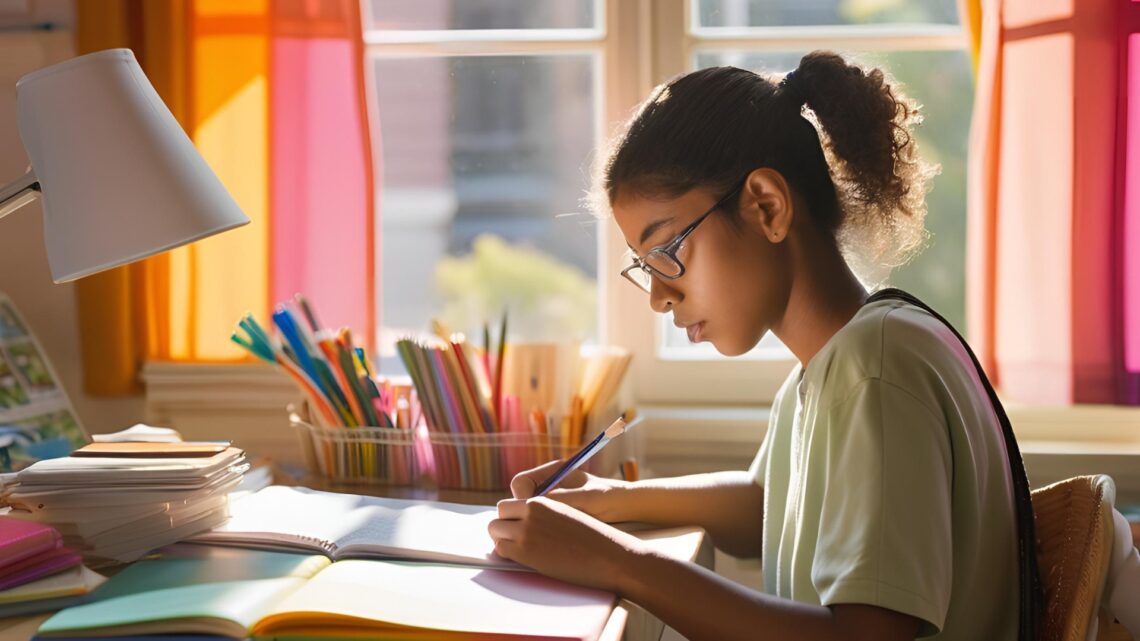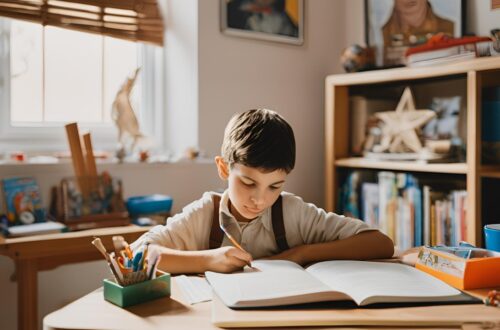
Top 10 Study Tips for Primary School Students
Developing effective study habits is essential for primary school students as it lays the groundwork for academic success. At this formative stage, nurturing a love for learning through practical study tips can significantly enhance a child’s educational journey. In this post, we will explore ten practical study strategies to help young learners thrive.
Create a Study Schedule
Creating a study schedule helps primary school students manage their time and avoid last-minute cramming. Start by looking at their weekly routine and identifying blocks of time that can be dedicated to studying. It’s important to choose times when they are most alert, such as after a snack or a bit of exercise.
A good study schedule includes a mix of subjects to keep things interesting. For instance, if your child has maths and reading homework, alternate these subjects so they don’t get too bored or tired of one. Also, make sure to include some free time and activities they enjoy. This balance can make studying feel less like a chore and more like a regular part of their day.
Using a calendar or planner can be very helpful. You can use different colours for different subjects or activities to make it more visually appealing. Children can also get involved by decorating their planners or choosing stickers to mark completed tasks. This visual approach makes it easier for them to see what needs to be done and when.
It’s crucial to review and adjust the schedule as needed. Life can be unpredictable, and sometimes activities will come up that might disrupt the study plan. Teach children to be flexible and to adjust their schedules to fit around these changes.
Consistency is essential, but it’s also important to be realistic. Start with shorter study periods and gradually increase the time as your child becomes more comfortable with the routine. By setting up a well-organised study schedule, you’re helping them build a strong foundation for their academic future.
Find a Quiet Study Space
Finding the right place to study can make a big difference in how well children focus and learn. A quiet study space means fewer distractions, helping students to concentrate better. This space doesn’t need to be fancy; it could be a corner of a room, a small desk or even a spot at the kitchen table. What’s important is that it’s a place where they can sit comfortably and have everything they need within reach.
Make sure the study area is away from noisy places like the TV room or the kitchen when meals are being prepared. If it’s not possible to find a completely quiet place, consider using noise-cancelling headphones or soft background music to block out distractions.
Good lighting is also key. Natural light is best, but if that’s not available, a good desk lamp can help reduce eye strain and keep students alert. Keep the study space tidy and organised, with all necessary supplies like pens, paper and textbooks easily accessible. This will save time and prevent frustration from constantly looking for things.
It’s also helpful to personalise the study space. Let children decorate their area with some of their favourite items or drawings. This makes the space feel more inviting and can make studying a bit more enjoyable. A comfortable chair is important too, as it helps maintain good posture during study sessions.
Having a designated study space also signals to the brain that it’s time to focus and learn, much like how going to school does. This habit can greatly enhance a child’s ability to study effectively.
Set Clear Goals
Setting clear goals can help students stay focused and motivated. Start by helping children understand what they need to achieve. For example, if they have a project, break it down into smaller tasks like researching, writing and creating visuals. Each small task should have its own deadline, making the whole project feel more manageable.
Goals should be specific and realistic. Instead of a vague goal like “study science”, try something more detailed like “read chapter three of the science book and take notes”. This way, children know exactly what they need to do and can see their progress.
It’s also useful to write these goals down. Use a planner, whiteboard or even sticky notes. Seeing their goals in writing makes them more tangible and harder to ignore. Encourage children to tick off completed tasks, which gives a sense of accomplishment and boosts their confidence.
Rewarding progress is another good motivator. Simple rewards like a favourite snack, extra playtime or a small treat can make a big difference. Rewards give children something to look forward to and make achieving goals feel more exciting.
Teach children to be flexible with their goals. Sometimes things don’t go as planned, and that’s okay. If a goal isn’t met, encourage them to figure out why and adjust their plan. This teaches problem-solving skills and resilience.
Lastly, lead by example. Share your own goals and show them how you work towards achieving them. Seeing adults set and meet their goals reinforces the importance of this skill. By setting clear goals, children can develop a sense of direction and purpose in their studies.
Use Active Learning Techniques
Active learning techniques engage children in their studies, making the process more interactive and enjoyable. One effective method is summarising what they have learned. After reading a chapter or completing a lesson, ask your child to explain the main points in their own words. This exercise reinforces their understanding and helps them retain information better.
Another great technique is teaching back. Have your child pretend to be the teacher and explain the material to you or a sibling. This role reversal not only makes learning fun but also highlights any gaps in their knowledge. If they struggle to explain a concept, it’s a signal that they need to revisit that part of the material.
Creating mind maps is also a helpful strategy. Encourage your child to draw diagrams that connect different ideas or facts. This visual representation makes it easier to see how various pieces of information relate to each other. Use different colours and images to make the mind maps more engaging.
Interactive activities like quizzes and flashcards can also be very effective. Create simple quizzes on the topic they are studying or use flashcards to test their knowledge. This keeps the learning process dynamic and helps with memory retention.
Encourage children to ask questions and be curious. If they come across something they don’t understand, prompt them to look it up or discuss it with you. This habit of questioning and exploring fosters a deeper understanding of the subject matter.
Incorporating these active learning techniques into study sessions can make learning more enjoyable and effective for primary school students. These methods not only help with retaining information but also build critical thinking skills.
Take Regular Breaks
Taking regular breaks is essential for keeping your mind fresh and focused during study sessions. The brain can only concentrate for a limited time before it starts to get tired. By breaking up study time into smaller chunks, students can maintain their attention and improve their ability to retain information.
A good approach is to follow the Pomodoro Technique, which involves studying for 25-30 minutes and then taking a short 5-minute break. During these breaks, it’s important to do something different from studying. Stretching, walking around or having a quick snack can help recharge the brain and body. Avoid screens during these short breaks, as they can be overstimulating and make it harder to refocus afterwards.
Longer study sessions should include more extended breaks, such as 15-20 minutes after every two hours of studying. This provides a chance to rest more thoroughly, perhaps by playing outside, doing a favourite hobby or simply relaxing. These longer breaks can help prevent burnout and keep the study routine enjoyable.
It’s also helpful to encourage children to listen to their bodies. If they feel particularly restless or tired, an unscheduled break might be needed. Flexibility in taking breaks can prevent frustration and make the overall study experience more positive.
By integrating regular breaks into study sessions, students can improve their concentration, memory and overall academic performance.
Stay Organised with Materials
Staying organised with materials is crucial for primary school students to keep their studies running smoothly. A good system for organising can save time and reduce stress. Start by providing your child with folders or binders for each subject. This way, all their papers and notes for maths, English and other subjects have their own place. Encourage them to label these folders clearly, so they can quickly find what they need.
Notebooks are another essential tool. Having separate notebooks for different subjects helps keep notes in order. Choose notebooks that are durable and can withstand daily use. It’s also useful to date the pages, making it easier to find specific information later on. Using coloured tabs or sticky notes can help mark important pages, like homework assignments or key concepts.
A tidy desk or study area contributes significantly to staying organised. Ensure that pens, pencils, rulers and other supplies are easily accessible. Desk organisers or small storage boxes can help keep everything in its place. Teach children to tidy up their study area regularly, preferably at the end of each study session, so it’s ready for the next time they need to work.
Digital tools can also be handy for staying organised. Simple apps or online calendars can help keep track of homework deadlines and test dates. Encourage your child to update their calendar regularly and check it daily to stay on top of their tasks.
Developing these organisational habits early on can make a big difference in a child’s academic journey, helping them stay focused and reducing the time spent looking for misplaced items.
Use Visual Aids
Visual aids are fantastic tools for making difficult information easier to understand. They work especially well for children who learn better by seeing things rather than just hearing or reading about them. One great way to use visual aids is by creating charts and graphs. These can help break down data and show it in a way that’s easy to grasp. For instance, a pie chart can show different parts of a whole, making it simpler to understand fractions or percentages.
Mind maps are another excellent visual tool. They allow children to organise their thoughts and see how different ideas are connected. Encourage your child to use different colours and drawings to make their mind maps more engaging. This not only makes the learning process more enjoyable but also helps them remember the information better.
Diagrams and drawings can also be very helpful, especially in subjects like science and geography. For example, drawing a labelled diagram of the water cycle can make it easier for children to understand how it works. Encourage your child to use their creativity when making these diagrams; the more personal they make them, the more memorable they will be.
Using flashcards with pictures is another effective technique. These are especially useful for learning new vocabulary or historical events. You can even turn it into a game by having your child match the picture with the correct term or date.
Encourage children to create these visual aids themselves. The process of making them can be a learning experience in itself, helping to reinforce the material in their minds.
Practice Past Papers
Practising past papers is a fantastic way for students to get used to the kinds of questions they’ll see in exams. By working through these papers, they can better understand what to expect and feel more confident on exam day. It also helps them identify which topics they are strong in and which areas need more attention.
Encourage students to time themselves while completing past papers. This will help them practise managing their time effectively during the actual exam. For instance, if they have a two-hour exam, they should try to complete a past paper within that same time frame. This practice can reduce exam stress and improve their ability to answer questions quickly and accurately.
Additionally, reviewing the answers after completing a past paper is crucial. Go through the marking scheme with your child to see where they did well and where they made mistakes. This can be a great learning opportunity, helping them understand how to structure their answers and what examiners are looking for.
It’s also helpful to create a quiet, exam-like environment when practising. This helps children get used to working under exam conditions, making the actual exam less intimidating. If possible, use different past papers to cover a variety of topics, ensuring a well-rounded review.
By incorporating past paper practice into their study routine, students can build their confidence and improve their performance in exams.
Stay Healthy
Staying healthy is essential for doing well in school. A good diet and regular exercise can make a big difference in how well children learn and concentrate. Start by making sure your child eats a balanced diet. Include plenty of fruits and vegetables, whole grains and protein-rich foods like chicken, fish and beans. These foods give them the energy they need to focus and stay alert.
Breakfast is particularly important. A nutritious breakfast can kick-start the brain and make it easier for children to concentrate throughout the day. Simple options like whole-grain cereal with milk, a piece of fruit or toast with peanut butter can do wonders.
Exercise is just as important as a good diet. Physical activities like playing outside, riding a bike or even just walking can help keep the body and mind in good shape. Aim for at least 60 minutes of physical activity each day. Exercise not only boosts mood but also helps children release energy and stress, making it easier to focus when it’s time to study.
Sleep is another key factor. Ensure your child gets enough sleep each night, as a well-rested brain is more capable of learning and retaining information. Establish a regular bedtime routine to help them wind down and prepare for a good night’s sleep.
By promoting healthy habits, you can help your child maximise their academic potential.
Ask for Help When Needed
Asking for help is a vital part of learning and growing. Encourage children to speak up if they’re confused or stuck on a subject. Teachers are there to help and will appreciate knowing which areas students find challenging. Parents and older siblings can also provide support, whether it’s explaining a tricky maths problem or helping with a project.
It’s important for children to understand that needing help is normal and that everyone encounters difficulties. Encourage them to form study groups with friends, as discussing topics together can make learning easier and more enjoyable. Online resources, like educational videos and tutorials, can also be helpful if they prefer to learn independently.
Building the confidence to ask questions and seek assistance can significantly boost a child’s learning experience. It shows they are proactive about their education and willing to take steps to understand the material better. This habit not only helps them succeed in school but also prepares them for future challenges in life.

You May Also Like

Essential Study Tools Every Student Needs

How to Create the Perfect Study Environment at Home
